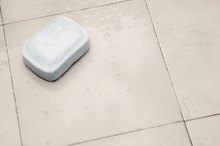What does fact checked mean?
At Healthfully, we strive to deliver objective content that is accurate and up-to-date. Our team periodically reviews articles in order to ensure content quality. The sources cited below consist of evidence from peer-reviewed journals, prominent medical organizations, academic associations, and government data.
The information contained on this site is for informational purposes only, and should not be used as a substitute for the advice of a professional health care provider. Please check with the appropriate physician regarding health questions and concerns. Although we strive to deliver accurate and up-to-date information, no guarantee to that effect is made.
How to Remove Gauze That Sticks to Wounds
Attempting to remove a wound dressing that is stuck to the wound bed is painful and disruptive to the healing process. Some gauze dressings can be used to cover a wound and other gauze dressings may be packed into a wound. Drainage can dry on the gauze causing the dressing to stick to the wound 2. This adhesion can cause problems since as wounds heal they fill with new tissue and improperly removing a stuck dressing can rip some of that healthy tissue out. Knowing the proper steps to loosen a stuck dressing can make the person with the wound more comfortable and can decrease delays in wound healing.
Wash your hands with tap water and soap before attempting to remove the wound dressing. Dry your hands well.
How to Use Aquacel
Learn More
Take your prescribed pain medication before attempting to remove the dry gauze just in case you experience any pain.
Apply sterile normal saline or tap water to the wound 2. For a small wound, wet a cotton-tipped applicator or a cotton swab with tap water or sterile normal saline and rub the swab over the stuck portion of the dressing. For a medium to large wound, pour sterile normal saline or tap water directly over the dressing.
How to Use Promogran Prisma Matrix Wound Dressing
Learn More
Gently and carefully attempt to lift the gauze. Apply more water as needed to soften the stuck dressing.
Dispose of the used dressing. Wash your hands with soap and tap water.
Cleanse and re-dress the wound as ordered by the physician.
Tips
Discuss with your physician the use of a different type of dressing, such as a non-adherent gauze dressing, if you have problems removing your dressings.
Warnings
Some dressing techniques, such as wet-to-dry dressings, are meant to be removed when dry. If you are performing this type of dressing change, contact your physician for advice related to wetting the dressing before removal. A wet-to-dry dressing is meant to debride the wound.
Related Articles
References
- MedlinePlus: Surgical Wound Care
- Wound Care Information Network: Tips and Tricks
- Wound Care Information Network: Type of Wound Debridement
- Mccaughan D, Sheard L, Cullum N, Dumville J, Chetter I. Patients' perceptions and experiences of living with a surgical wound healing by secondary intention: A qualitative study. Int J Nurs Stud. 2018;77:29-38. doi:10.1016/j.ijnurstu.2017.09.015
- Krafts KP. Tissue repair: The hidden drama. Organogenesis. 2010;6(4):225-33. doi:10.4161/org.6.4.12555
- Chetter IC, Oswald AV, Fletcher M, Dumville JC, Cullum NA. A survey of patients with surgical wounds healing by secondary intention; an assessment of prevalence, aetiology, duration and management. J Tissue Viability. 2017;26(2):103-107. doi:10.1016/j.jtv.2016.12.004
- Singh PK, Saxena N, Poddar D, et al. Comparative Study Of Wound Healing In Primary Versus Delayed Primary Closure In Contaminated Abdominal Surgery. Hellenic J Surg. 2016;88:314–320. doi:10.1007/s13126-016-0340-8
- Surgical Patient Education Program: Prepare for the Best Recovery. American College of Surgeons. 2018.
- Rushbrook JL, White G, Kidger L, Marsh P, Taggart TF. The antibacterial effect of 2-octyl cyanoacrylate (Dermabond®) skin adhesive. J Infect Prev. 2014;15(6):236-239. doi:10.1177/1757177414551562
- Lazar HL, Mccann J, Fitzgerald CA, Cabral HJ. Adhesive strips versus subcuticular suture for mediansternotomy wound closure. J Card Surg. 2011;26(4):344-7. doi:10.1111/j.1540-8191.2011.01257.x
- 3M Wound Resource Center. http://solutions.3m.co.uk/wps/portal/3M/en_GB/skin-care/wound-resource-centre/
Tips
- Discuss with your physician the use of a different type of dressing, such as a non-adherent gauze dressing, if you have problems removing your dressings.
Warnings
- Some dressing techniques, such as wet-to-dry dressings, are meant to be removed when dry. If you are performing this type of dressing change, contact your physician for advice related to wetting the dressing before removal. A wet-to-dry dressing is meant to debride the wound.
Writer Bio
Since 2008, Jennifer S. Wright has written articles on a variety of topics including parenting concerns, medical conditions and nursing issues. Her articles have appeared in "LPN" magazine as well as on various online publications. An LVN since graduating from Weatherford College in 2005, Wright has taken care of elderly, pediatric and obstetric patients in hospital and home health care settings.




